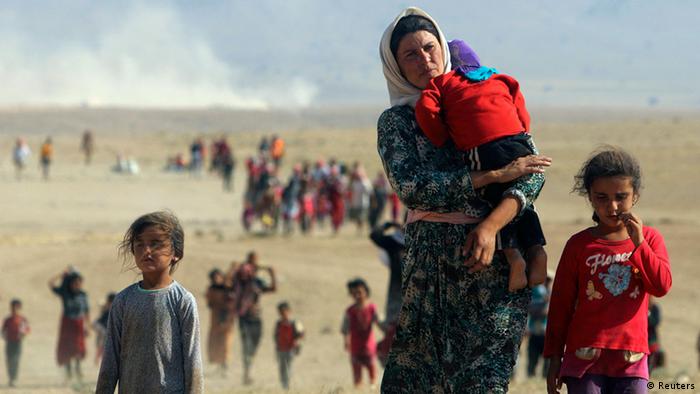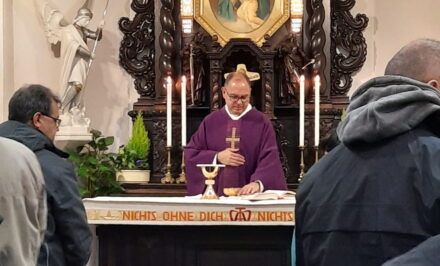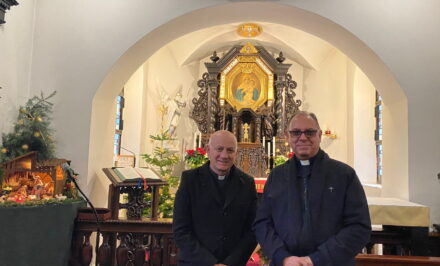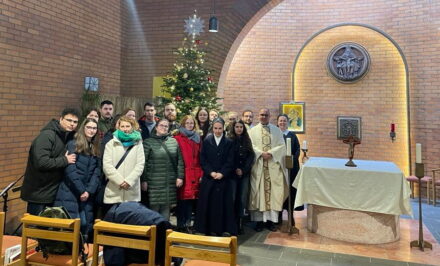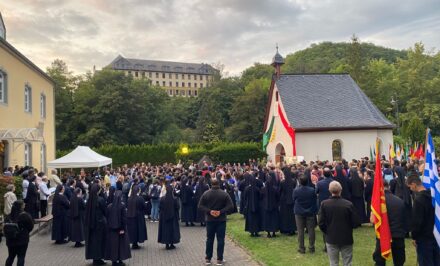
![]() mda. And it happened at that time, in the time after Schoenstatt’s jubilee … they appeared at the doors of Schoenstatt – men, women and children who had fled their homes with nothing but their lives: traumatised, lost, homeless … They sought shelter … And the hearts of the people there, where a hundred years earlier they had been surrounded by war, opened to them. Not just hearts, but also houses, empty houses, houses in which people moved closer together to take them in. They moved in and experienced that they were welcome and loved. A Christmas fairy tale? Or, perhaps …?
mda. And it happened at that time, in the time after Schoenstatt’s jubilee … they appeared at the doors of Schoenstatt – men, women and children who had fled their homes with nothing but their lives: traumatised, lost, homeless … They sought shelter … And the hearts of the people there, where a hundred years earlier they had been surrounded by war, opened to them. Not just hearts, but also houses, empty houses, houses in which people moved closer together to take them in. They moved in and experienced that they were welcome and loved. A Christmas fairy tale? Or, perhaps …?

It all started when Pope Francis visited Lampedusa – an island that has become a symbol of the drama of the refugees looking for a better life. In the attempt they founder, drown, or find themselves stranded in over-crowded camps. … Who of us has wept for the children, women and men who drowned in the Mediterranean, Pope Francis asked. Who allowed themselves to be touched by what has happened? A dream arose in some hearts … a dream of Schoenstatt Centres, which, like so many Abbeys, convents and parish houses, opened to welcome the refugees. “Empty houses in Schoenstatt as Refugee Homes – the Covenant House, Summer House, Sonneck, Novitiate …, and refugees from the Middle East or Africa on the holy mountains – would we every see it? … “Unthinkable! Absolutely unthinkable!” Such a conversation took place between some colleagues of schoenstatt.org a few months ago. They were completely mistaken.
Who do we hear when we are praying in the Original Shrine?
Fr Egon M. Zillekens, recalled the sermon of Auxiliary Bishop Michael Gerber on 18 November during the Covenant Mass in the Pilgrims’ Church. “His words touched me, they touched me deeply, and left me no peace”, he said.
“As with Mary in Nazareth, the sealing of the covenant leads Schoenstatt into the world. Mary went to Elizabeth to help her in her time of worry and need. The worries and needs of the little ones and the big world of 1914 came to meet our Father only 20 metres away from the shrine”, Bishop Gerber said. “There in the Old House the students were living in cramped quarters, because the College buildings had been turned into a field hospital. The war made itself felt, and it is quite possible that from time to time the people praying quietly in the shrine heard the groans and cries of the wounded up in the College. Whom do we hear when we pray in the shrine? Last week it touched me deeply when a Sister of Mary told me that one of our large Schoenstatt Centres (Liebfrauenhoehe in S. Germany) would soon be creating space for refugees from the Middle East. Those who know that Centre can well imagine that the people praying quietly in the shrine will easily hear the refugees and their children. … People moving closer together to make room for the wounded. It moves me at the moment, as the episcopal vicar for the religious Orders and Secular Institutes of our diocese, to see how much dynamic life is awakened in communities when they have to make room for the wounded. It could be an inspiration to reflect in practical terms at our Schoenstatt shrines and centres, where we often worry about how to fill them: Where is there room for the wounded of the wars of our times?”
What about at Schoenstatt itself? Fr Zillekens said, “I immediately asked myself: We had so many volunteers here at the jubilee, but they have gone, their rooms are empty … Will we take in refugees?”
When doors simply open

Wilfried Münz (53), who lives in Niederwerth, represents the Vallendar Mayor, Fred Pretz, as a member of the association of municipalities, so is part of a vast network. As a convinced Christian he knew that Vallendar would soon have to take in 150 refugees. He asked in Schoenstatt. His request was passed on to the General Presidium, the site commission, and “now I’m the point of contact for the request to take in refugees in Schoenstatt’s facilities”, Fr Zillikens remarked. Projects and initiatives of a covenant culture do not start in theory, but in dialogue with the voices of the times. With the voice of a committed politician. With the voices of the religious Orders and Secular Institutes that have opened their houses. With the voices of people who give Pope Francis a voice: “Here I cannot fail to recall the many instances of injustice and persecution which daily afflict religious minorities, and Christians in particular, in various parts of our world. Communities and individuals today find themselves subjected to barbaric acts of violence: they are evicted from their homes and native lands, sold as slaves, killed, beheaded, crucified or burned alive, under the shameful and complicit silence of so many. …We cannot allow the Mediterranean to become a vast cemetery! The boats landing daily on the shores of Europe are filled with men and women who need acceptance and assistance. “ (Address to European Parliament, News.va)
The Christmas fairy tale has not yet become a reality. Fr Zillekens is in discussions with the authorities in Schoenstatt; there is talk of the “Summer House”, the former house for students of the Schoenstatt Fathers, an application has been made to the management association of the Covenant House, and other possibilities are being explored. All this is going on in co-operation with the local politicians in Vallendar. The doors are open. “Will the refugees really arrive?” we asked Fr Zillekens. “I firmly believe so”, he replied as he pointed to the mud into which Bishop Gerber has sent the Schoenstatt Movement. Mud?
A bit of heaven in the mud
“I think it would do us good, who have grown up in more peaceful times, to visit those places now and again as a spiritual exercise, and to visualize the dirt and the mud that dominated there, both in the clothes of the people and in their souls”, Bishop Gerber remarked on 18 November. “Perhaps it is precisely on this account that the lawn next to the Original Shrine is so muddy at the moment. The path of the foundation led directly into the mud. Our founder generation did not remain at that initial stage. They weren’t satisfied with analyzing the situation and working out some essential principles. No, they became part and parcel of the turmoil. For them – and it is just that that seems to me to be so important today – the existential anguish of their times bore actual faces. The battered face of a wounded comrade at arms, the brokenness of a number of biographies. To be in touch with life, that is what our Father spoke about.
A suggestion for the monthly spiritual renewal: Have I allowed the fate of definite people to touch me deeply this month? Whom did I meet, or which report have I studied more intensively? Or – to ask self-critically: Do I even read such things, do I sometimes go to places where I could meet such people? Do I enter into a discussion; am I able to cope with the emotions of people I encounter who have been hurt, also through experiences in our Church? Go out into the turmoil, go out into the mud! This was how our co-founders became missionaries. Others felt that these Schoenstatters are standing with us in the mud, they live in profound solidarity, and yet they are marked by another lifestyle because another world is alive in them, a bit of heaven in the midst of the mud …” And a bit of mud, of misery, the real misery in this world in the midst of the “heaven” of Schoenstatt.
Could we have imagined it? The co-operators of schoenstatt.org mentioned before are at any rate incredibly happy that they were wrong.
Original: German. Translation: Mary Cole, Manchester, UK
